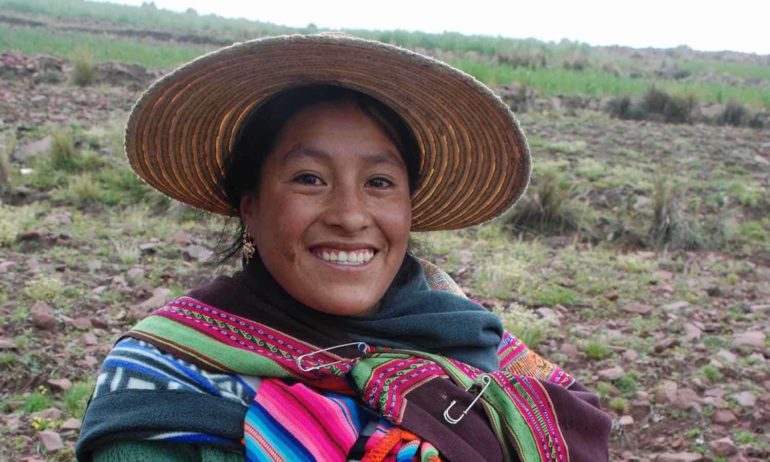In the early 2000s, Susan Walsh took a break from her career in international development to do PhD research among the Jalq’a, a community of Indigenous potato farmers in the Bolivian Andes. She was especially interested in impact on the Jalq’a of capacity-building programs introduced by national, international, and multilateral development organizations. She observed that, in their efforts to help, development groups pushed for changes in food production that wound up eroding local resilience strategies and driving farmers off their land. In 2012, she published a first-hand account of her experiences entitled Trojan Horse Aid: Seeds of Resistance and Resilience in the Bolivian Highlands and Beyond. Food Tank sat down with her to discuss the book in Ottawa, Canada, where Walsh is executive director of USC Canada, a non-profit, international development organization that works to improve livelihoods by promoting agricultural biodiversity.
Food Tank (FT): What motivated you to write the book?
Susan Walsh (SW): I wanted to explore some of the contradictions I’d noticed over the years in the way the development industry works with communities like the Jalqa, in the global south. Development groups are well-intentioned but they tend to operate with a deficit mentality, looking for what’s missing in a community rather than what’s already there. Instead, I believe we need a deeper understanding of the communities we work with, and a greater respect for the strengths that have allowed them to survive in the first place.
When it comes to food production, many development efforts have promoted industrial technologies to solve food system problems and have discounted the knowledge of small-holder farmers who still produce a majority of the world’s food.
FT: What strategies for resilience did you observe in the Bolivian highlands?
SW: Resilience in a culture or system is about its being able to deal with change or shock and still keep its essential character. In the case of the Jalq’a, their food production was rooted in a traditional pan-Andean system, known as ecological complementarity, which fosters resilience.
I’m oversimplifying here, but eco-complementarity involves cooperative management and cultivation of lands at different altitudes – for example, potatoes and tubers at higher elevations, grains at mid-levels, and so on, along with careful crop rotations. It’s designed to protect against unpredictable mountain microclimates and ensure a supply of food for the community. The emphasis on growing conditions, soil fertility, and diversity over yield and productivity make it a very strategic approach to food security and resilience that’s linked to the people’s sense of who they are, of their landscape, and of their responsibilities to each other.
Unfortunately Western development projects introduced among the Jalq’a in the 1980s and 1990s eroded this resilience.
FT: How did that happen?
SW: There was a tendency to view Indigenous farming practices as antiquated and to promote Western-style, large-scale food production technologies, such as monocropping and chemical use, to lift the people out of subsistence and semi-subsistence farming.
As the Jalq’a adopted industrial practices, their food supply became less diverse, less secure. For example, the many nutrient-dense, native potato varieties traditionally grown in this part of the world were replaced by a couple of water-filled varieties, intended for use in chip and French fry machines, and chemically intensive to grow. Over time, the Jalq’a began losing their knowledge of ancestral varieties and how to grow them organically.
Reliance on synthetic pesticides and fertilizers resulted in severe soil erosion and infertility and fueled the use of even more pesticides and fertilizers. Farmers couldn’t earn enough cash from market sales to cover the cost of these chemicals, so it became a common strategy to move to the city for short periods to find work. Access to loans was tied to continued chemical use.
And there were health impacts. In the global south, when agricultural chemicals are brought in, many farmers can’t afford the masks, gloves and other gear they need to protect themselves when they apply them.
Fortunately, the situation for the Jalq’a has improved in recent years. They are reverting to organic production and to more diverse native varieties of food plants. Soil and yields are recovering.
FT: What do you think needs to change in the development industry’s approach to food systems?
The most common international response to a food challenge is to turn to new technologies. The worry is that we can’t feed the world’s growing population without the West’s more “efficient”, large-scale production techniques. But these techniques damage the environment and long-term sustainability. Most analysts agree that hunger is less a question of agricultural limits and more a matter of access to food and the means to produce it. It’s an economic and political issue rather than a technological one.
Capacity-building programs should start with the strengths that are already in a community, and especially with the family farmers who have a deep knowledge of place and local diversity. In light of climate change and other risks to the global food supply, the long-term security of any population will depend on the options diversity makes available.













